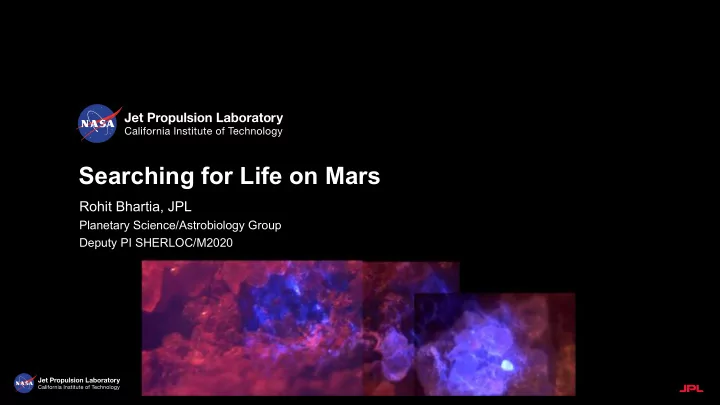

Searching for Life on Mars Rohit Bhartia, JPL Planetary Science/Astrobiology Group Deputy PI SHERLOC/M2020
What to take away from this talk • Life tends to “clump” in fractures/voids. Getting spatial context combined with chemistry is necessary. • There is no one “best” method of analysis: Each technique has its unique capabilities and its challenges…. So combine them. • What targets can be measured to search for life and what are the challenges 2/12/18 2
Signatures of Life on Mars? Phoenix Lander Viking Landers Curiosity/MSL GC/MS + Sample GC/MS + Sample GC/MS + Sample Handling Handling Handling Organics: Inconclusive Organics: Yes Organics: Inconclusive Indications of a highly oxidizing Organics altered by Detection of Perchlorates environment Perchlorates Mars 2020 SHERLOC: Deep UV Fluorescence/Raman Mapping PIXL: X-ray Fluorescence Mapping SuperCam: Time-gated Visible Raman spectroscopy
Searching for Biosignatures Which of these have life or possibly signs of life, and how to do you know where to start? Tissint Cold Seep Carbonate Subsurface Ice C=C vib. -CH Str. Ring Str. 100 µ m
Hollow carbon spheres bacteria
Searching for Life through Biosignatures • Biosignature: any substance – such as an element, isotope, molecule, or phenomenon – that provides scientific evidence of past or present life. • Bulk Analysis Methods: (GCMS/LC/CE/etc.) detection and identification of specific molecules, ratios of specific organics, organic inventory, etc. • Mapping/Imaging Methods: (Raman/XRF/SIMS/SEM EDS/Microscopy etc.) detection and identification and spatial distributions of molecules and elements and provides morphology with chemistry *apologies for not listing all possible instruments – suffice it to say there are many options out there
Bulk and Mapping/Imaging analyses Its not a matter of which is “better” Bulk analysis: - Ingests a sample à Extracts materials of interest à Concentrates à Detects - Enables separation of mixed materials by chromatography - Detection observes extracted and processed material at ppb to ppt levels - Loss of mineral/organics spatial context - Cross reactions/alteration from matrix possible Mapping/Imaging: - Illuminate sample à Detect signal à Move to next volume - Maintains mineral/organics spatial context - Detection of material down to 1 cell/view volume - Small volume analysis: need to illuminate material of interest to detect - Identification difficult in mixed systems without increased spatial resolution 2/12/18 10
Bulk and Mapping/Imaging analyses Its not a matter of which is “better” Deep Biosphere/Subsurface Ice Environments on Earth Bioload is ~ 1x10 3 to 1x10 4 cells/cm 3 - Assume 1 cell has 200fg C (2x10 -13 g C) and rock is ~2.5g/cm3 - - But what is the distribution? Assuming Even Distribution Assuming Clustering 0.5mm 100-1000cells/cluster 1cell Bulk: Detection by concentration (sub ppb) Bulk: Detection but will loose knowledge of clusters Scanning/mapping: Single cell detection needed Scanning/mapping: single cell detection not needed Thus requires 10million analyses/cm 3 Use in conjunction (Scan to target bulk analysis) 2/12/18 11
Life in Fractures/voids 1cm 2/12/18 12
Life in the fractures 2 µm 10 4 cells/cm 2 on the fracture • 1 : m surface • Sessile population is 100-1000x the number of planktonic cells measured in the borehole water • Very slow doubling times (Kieft & Phelps, 1997) 2 µm 1 : m
Defining Life: What do we look for? “Life is a self sustaining chemical system capable of Darwinian evolution” 1. Life as we know it on Earth - contains DNA/RNA/proteins/fatty acids - key biosigs example hopanes/isotopes - Note: We are continuously learning about life on Earth Both approaches are necessary 2. Non-Earth Centric approach (General Life) - assume life on Earth is not the only solution - another set of amino acids to another structure - detection of “patterns” that are indicators of life 2/12/18 14
What can you measure? Astrobiology Ladder • Growth/Reproduction • Metabolism • Functional Molecules • Potential Biomolecules components • General Indicators S. Pirbadian et al 2014 Sep 2; 111(35): 12883– Technique: Labeled Fluorescence Microscopy 12888. doi: 10.1073/pnas.1410551111 https://astrobiology.nasa.gov/research/life-detection/ladder/ 2/12/18 15
What can you measure? Astrobiology Ladder • Growth/Reproduction • Metabolism Shew Mn04 • Functional Molecules • Potential Biomolecules components • General Indicators Technique: Time-lapse DIC Microscopy/SIMS https://astrobiology.nasa.gov/research/life-detection/ladder/ 2/12/18 16
What can you measure? Astrobiology Ladder • Growth/Reproduction • Metabolism • Functional Molecules • Potential Biomolecules components • General Indicators Proteins DNA Technique: OMICs/MS/Raman/IR/CE Adapted from https://astrobiology.nasa.gov/research/life-detection/ladder/ 2/12/18 17
What can you measure? Astrobiology Ladder • Growth/Reproduction • Metabolism • Functional Molecules • Potential Biomolecules components • General Indicators Technique: Raman/MS/IR/CE Adapted from https://astrobiology.nasa.gov/research/life-detection/ladder/ 2/12/18 18
What can you measure? Astrobiology Ladder Wide range of organic molecules Concentration In addition to amino acids and nucleic acids (found in life), it has a wide distribution of many types of organics • Growth/Reproduction Type of Organic Molecule • Metabolism Select organic molecules Concentration • Functional Molecules Type of Organic Molecule • Potential Biomolecules components • General Indicators Technique: Mass Spec/LC/XRF/Raman Adapted from https://astrobiology.nasa.gov/research/life-detection/ladder/ 2/12/18 19 Chert Organics Dolomite
Organics: Abiotic vs. Potential Biosignatures Abiotic Synthesis Life Asteroids/Comets/IDPs* Native Planetary Processes infall Polyaromatic Hydrocarbons Amino Acids Nucleic Acids Chemistry Gone “wild” Microbes: small discrete packages of organics Proteins/DNA: 2º/3º assemblies Amino Acids : 20 specific ones Nucleic Acids: 5 specific ones Time/Pressure/Heat Cosmic Radiation/UV Fatty acids Organized Chemistry Altered Product *IDPs: Interplanetary Dust Particles
16:0 & 18:0 CN
N
Levett et al . 2016 Wanger et al . 2008
Conclusions • Life tends to “clump” in fractures/voids. Getting spatial context combined with chemistry is necessary. • There is no one “best” method of analysis: Leverage the clumped nature of life to couple mapping and bulk methods. • Use both terrestrial focused targets and non-earth centric approaches to search for life. 2/12/18 25
Acknowledgements Jan Amend, USC Abigail Allwood, JPL NAI – Life Underground Luther Beegle, JPL PSTAR – WATSON Katrina Edwards, USC M2020- SHERLOC Moh El-Naggar, USC Evan Eshelman, Caltech William Hug, PSI Kenneth Nealson, USC Victoria Orphan, Caltech John Priscu, MSU Ray Reid, PSI Haley Sapers, USC/Caltech/JPL Greg Wanger, USC/Caltech/JPL Kris Zacny, Honeybee …. And many others
Questions? 2/12/18 27
Recommend
More recommend